Combine India's ancient Medic wisdom and doll-making artistry with America's multimedia technology… and you get an unforgettable spiritual experience.
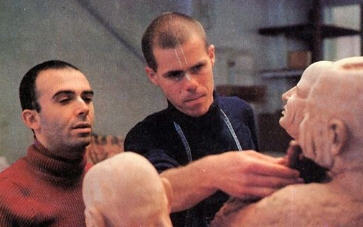
The inspirational seed for the First American Theistic Exhibition (just opened at the Los Angeles Radha-Krsna temple) was planted in India more than forty years ago by Srila Bhaktisiddhanta Sarasvati Thakura, the grand-spiritual-master of the Krsna consciousness movement. It was then that he developed an impressive diorama exhibit to present the philosophy of Krsna consciousness clearly and convincingly to all classes of people. That original theistic exhibition, consisting of dozens of dioramas, still draws hundreds of thousands of viewers on its annual tour of India.
When His Divine Grace A.C. Bhaktivedanta Swami Prabhupada came to America in 1965, he brought with him his spiritual master's dream of an American theistic exhibition. To fulfill that dream, Srila Prabhupada asked some of his own disciples to go to India and learn the art of making "dolls," the figures displayed in a diorama. Now, by the grace of Lord Krsna and Srila Prabhupada, those disciples have returned to America and developed a unique and fascinating multimedia presentation of Krsna consciousness: the First American Theistic Exhibition.
The director of F.A.T.E. is Baradraja dasa, one of the first devotees Srila Prabhupada sent to India to learn the doll-making art. After becoming proficient, Baradraja has spent most of the last three years making dioramas and training others in the technique. He sees his assignment as a special favor from his spiritual master…
"I was working as an artist," Baradraja relates, "doing paintings for Srila Prabhupada's books at ISKCON's press in New York. As a devotee I had been painting for three years, and I was also doing art editing for BACK TO GODHEAD magazine. Then, in March of 1973, Srila Prabhupada came to New York. At that time I told him, 'Srila Prabhupada, I want to preach.' He looked at me like I was a lunatic. 'What are you doing now?' he said. 'You are not preaching? This painting is not preaching? Please understand, this is preaching. If you do not do this painting, then who will? No, this is very important preaching.' So that was the end of that painting illustrations for SrIla Prabhupada's books was preaching.
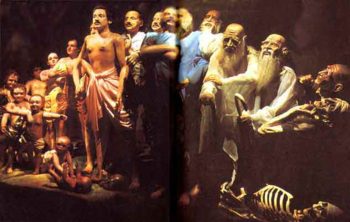
"A few days later, all the artists were talking with Srila Prabhupada in his quarters. (This was at the old Brooklyn temple.) He was asking about the various paintings we were working on, and there was a lot of discussion. Then suddenly he said something that surprised everyone; no one knew what to say. 'I want someone to learn how to make dolls,' he said. What did he mean? Of course, none of us actually knew what he was talking about. He just kept speaking of 'dolls.' He told us that these dolls were made in India. 'These doll makers are very expert. I want one of you to learn from them.' It was a complete mystery. What were these dolls? SrIla Prabhupada looked around the room. He looked at all the artists. Then he turned to me and said, 'Baradraja, you will go.'
"Well, I began to feel a very strange combination of emotions. In my heart there was both horror and joy: joy at having a chance to go to India, horror at the idea of having to make dolls. At the time, I thought of myself in quite a vain fashion as an artiste, one of good taste and aesthetic judgments. The idea of making dolls seemed really outlandish. But aside from my feelings, I knew the importance of the spiritual master's order. Here was an opportunity for spiritual advancement, and my wife and I were both eager and thankful for our new service to Srila Prabhupada. Practically speaking, this order to make dolls was the first real spiritual challenge in my whole life as a devotee. It was the first time that Srila Prabhupada had actually asked me to do something I didn't want to do. It was a very exciting time."
About this time Srila Prabhupada began to inspire other disciples to take up the mission of preaching Krsna consciousness through dioramas. He wanted these disciples to go to India, learn the art of doll making, and then return to the West and assemble an American theistic exhibit. In a letter to Adi-deva dasa, Srila Prabhupada wrote: "In London there is a museum Madame Tussaud's Wax Museum and people are lining up for blocks just to see some mundane dead bodies. You should go to India and learn how to make dolls. Then we will have our own museum, and simply by seeing our exhibits people will make spiritual advancement."
Training in India
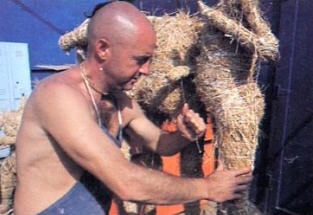
In the summer of 1973, the small group of devotees chosen by Srila Prabhupada to pioneer the diorama project arrived in India. Their destination was Sri Mayapur, the holy birthsite of Lord Caitanya Mahaprabhu. (Lord Caitanya is Krsna Himself, the Supreme Personality of Godhead. He appeared five hundred years ago to teach love of God through the chanting of the Hare Krsna mantra Hare Krsna, Hare Krsna, Krsna Krsna, Hare Hare/ Hare Rama, Hare Rama, Rama Rama, Hare Hare.) "Srila Prabhupada was staying at our ISKCON headquarters in Mayapur," Baradraja continued, "so of course I went there as soon as my plane landed in Calcutta. When I arrived in Mayapur, I immediately went upstairs to Srila Prabhupada's quarters. It was wonderful to see him there in Mayapur. He was relaxed and very much at home.
"As we talked he began to outline my new work. I was immediately to begin learning all about making dolls. Srila Prabhupada had already chosen a teacher, and I was to attend his classes. As I was leaving Srila Prabhupada's quarters, I ran into a Godbrother I hadn't seen in about four years. I told him what Srila Prabhupada had asked me to do why I had come to Mayapur and he started telling me a few things about India. We had stood there maybe five minutes at the most when Srila Prabhupada's secretary ran out and called to me, 'Baradraja, Srila Prabhupada wants to speak with you.' I couldn't imagine why. I had just finished talking with him. I ran back upstairs to his room and offered obeisances. I looked up. Srila Prabhupada was looking at me very sternly. He said, 'So, you can immediately begin this training program. There is so much to do; there will be no time for talking.' I don't know how he could have heard us talking, but from that moment on I knew: I had a lot of work to do, and Srila Prabhupada expected me to get a lot accomplished."
Adi-deva, another pioneer of F.A.T.E., recalls his early experiences in Mayapur learning the art of doll-making from his teacher and imbibing devotion to Krsna from Srila Prabhupada. "I remember the first thing we made in our class. The teacher had us sit down and make a clay mango. We showed it to him, and he rejected it and had us make another one, and another, and another. I must have made a dozen mangos, but he wanted us to make it exactly like the one he made.
"Once we got over the mango, he had us make a banana. Then an eggplant. Then a squash, and so on. Finally we graduated to making animals. We made monkeys and peacocks all quite small. It was really tedious, and we sometimes felt like quitting. But the thing that kept us all going was that we knew that one day this work would give pleasure to Srila Prabhupada. Of course, at this time none of us could begin to understand the scope of this project, the vision of our spiritual master.
"In the scriptures it is said that the disciple has to pass the test of the spiritual master. So this was my test: to stay in Mayapur and work only because my spiritual master wanted me to. Srila Prabhupada once told us, 'You should simply make and break.' We'd make a doll very carefully and exactly, and then wes the way he wanted us to learn. I can see now it was just like tearing off layer after layer of false egotism. Srila Prabhupada used to come up every morning after his lecture in the temple to see what wed broken any."
Dispelling Doubts
The dearest thing to a sincere disciple is the order of his spiritual master. Baradraja explains, "We had our order, and through the whole thing Srila Prabhupada confirmed that order and again and again enlivened all of us with his kindness. Then Srila Prabhupada went to Bombay on a visit. Without his daily encouragement I gradually began having some doubts about the whole idea of making dolls. So finally I flew to Bombay to see Srila Prabhupada. I had been in the hospital in Mayapur, and when I arrived in Bombay Srila Prabhupada had heard of my illness. He asked, How is your health? he was very kind and I said, 'Now that I am with you I'm perfectly all right.
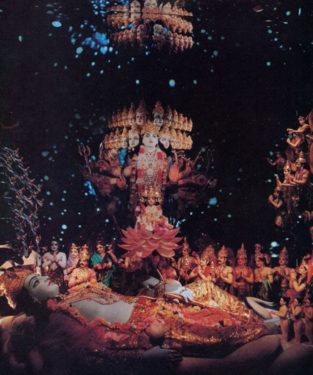
"Early that same morning, as the sun was coming up, I went with him on his walk along Juhu Beach. What he said to me that morning has become my life and soul. These words are what make me tick right now. Srila Prabhupada instructed me that morning on Juhu Beach: 'Learn this art of doll making. Become expert. If you take this to the West, then my preaching mission will become successful all over the world. So these words actually changed my life. From that day on. making dolls was a lot more than just a job or a task. It became my life's mission.
I learned another important lesson, you might say, when Srila Prabhupada asked us to make an exhibit in Mayapur for Lord Caitanya's appearance day. It was our first real project, and there wasn't really enough time to finish it all. I amde a doll of Lord Caitanya in His six-handed form, and one of Lord Nrsimhadeva [the half man, half-lion incarnation of Krsna], We finished on time, barely, and everyone who came was impressed. When Srila Prabhupada came to the doll of Lord Caitanya he asked, "Who has made this?" Someone said, "Baradraja did it." Srila Prabhupada thought for a minute as he looked at it. Then he turned to me and said, 'The hands are not yet perfect; you must study further. That was the first time I had noticed how very perceptive and critical Srila Prabhupada was of this diorama art. He actually wanted going to overlook anything.
"After that I began to feel a bit humble. When he came to the diorama of Lord Nrsimhadeva and asked, 'Who made this?' I replied that I had. 'Very good,' he said. 'Now you can teach others.' From these two incidents I could understand that, yes, he wanted me to teach, but on the other hand I had much more to learn. So I decided to remain in India and continue with my training.
"Finally, Adi-deva and I had the opportunity to go to Vrndavana [the small village (ninety miles from Delhi) where Lord Krsna appeared five thousand years ago]. We lived and worked in a little shed right next to Srila Prabhupada's quarters. Every day he would visit us during our work and point something out: 'This is too big. That is too small. Do this.' Whenever he was out he would almost always come over to the shop and see what we were doing. Then Srila Prabhupada became very sick. For almost two weeks we didn't see him at all. We just kept working on the dolls. When we had finished them, Srila Prabhupada's health was a little better, but he was till feeling very ill. One morning, after he had left his quarters for a short walk, we hurried in and put the newly finished dolls in his room as a surprise. And were we surprised! When Srila Prabhupada saw the dolls he became very happy. That morning his whole disposition changed and he felt in good health again. The significance, I think, was that by our work we were showing him we had learned what he had brought us to India to learn and that we were enthusiastic to go and begin theistic exhibitions in the West.
"A few days later I went with Srila Prabhupada on his morning walk and he told me, 'Yes, I have often thought that I have brought you here and given you so much trouble just so you would learn to do this important work. And now I see it was not in vain.' "
This marked the conclusion of fifteen months' training in India. Looking back over this period of preparation, Adi-deva recalls that the real motivation for all the devotees involved was the desire to please their spiritual master (which is actually the basic principle of spiritual life). "Going through that whole experience together helped everybody sense the importance that Srila Prabhupada was putting on this work. All the way through, whenever we would become discouraged or unsure, we'd either write to Srila Prabhupada, or Baradraja would go see him, or Prabhupada would come to visit us. And he just kept encouraging, always encouraging."
F.A.T.E. Comes to America
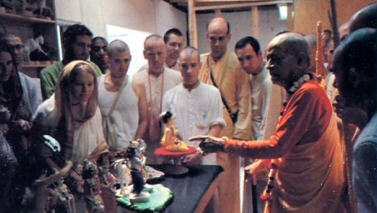
After returning from India, Baradraja, Adi-deva, and many other devotees (some who received training in India and others who simply felt attracted to F.A.T.E.) met at ISKCON's Western world-headquarters, in Los Angeles. Here they began the second phase in the development of theistic exhibitions in America.
"Before we constructed the present exhibit in Los Angeles," Baradraja explains, "we presented the whole idea to Srila Prabhupada, with models of all the dioramas. We marked off a corridor in the exhibit hall and set up models of the proposed dioramas all along the way. Srila Prabhupada toured the whole display and approved all our proposed exhibits. 'Very good,' he said, 'This is buddhi-yoga: you are utilizing your intelligence to preach Krsna consciousness. This is very nice.' "
"F.A.T.E. is a far-reaching project," says Baradraja. "Making dioramas incorporates every facet of the arts and crafts. Someone is a potter; someone is a jeweler; someone a carpenter, an architect, an engineer. We are engaging tailors, painters, photographers, stained-glass artisans. There is no field of art that the diorama construction doesn't touch. It opens up a whole new scope of activities for people in every field."
Devotees make the dolls at F.A.T.E.'s Los Angeles studio, using methods essentially the same as those used in India. The basic materials bamboo, rice straw, various clays, and rice husk are the same, as are the processes of finishing, painting, and dressing the dolls. But if you closely observe the doll makers at their daily work, you'll find many arts, crafts, and sciences and a lot of paraphernalia and equipment that definitely are not imported from India. For example, to make lighter, stronger, more portable exhibits, the devotees have developed a system of making rubber molds of the original dolls. From each mold a devotee can cast dozens of replicas much quicker than he could construct another clay doll. The cast forms are made of polyester resin, a light, strong material that can hold up under frequent shipping and handling.
F.A.T.E. even has its own electronics department, a vital part of the multifaceted project. At the new museum in Los Angeles, one specially designed computer synchronizes the entire exhibition, including varieties of lighting, a sixteen-track sound system, numerous film and slide projectors, and special visual effects. "We built our own computer," says F.A.T.E.'s electronics engineer Ameyatma dasa, "because we just couldn't find anything on the market that could handle such sophisticated programming."
The Significance of F.A.T.E.
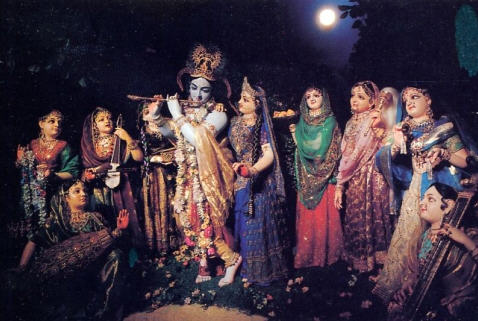
The development of F.A.T.E. points up the essence of Krsna conscious philosophy: we achieve our natural and happy condition when we employ our intelligence, our talents, our possessions everything in the service of Lord Krsna, the source and proprietor of all that is. Thus, Srila Prabhupada has taught his disciples how to become expert in using everything in the service of the Lord. Cars, printing presses, electronics, the technical and fine arts all can help spread Krsna consciousness, and devotees should use them. Actually, these things are meant solely for serving Krsna. But unfortunately our technological society does not know the eternal science of devotional service to Lord Krsna and therefore misuses everything for temporary sense gratification. Srila Prabhupada explains that without dedicating everything to Krsna, we waste our opulence and our technological advancement, and they become so many worthless zeros. Only by adding "one" Krsna can we turn all our zeros into millions and billions.
To give everyone a chance to add Krsna to his life is Srila Prabhupada's mission a mission given him by his spiritual master, Srila Bhaktisiddhanta Sarasvati Thakura, and the mission of a long line of spiritual masters dating back five hundred years to Lord Caitanya Mahaprabhu Himself. The First American Theistic Exhibition is an important step toward fulfilling that mission. Srila Prabhupada explains that people in this age aren't interested in reading philosophical books, and those who do read hardly understand. People aren't patient. They want to use their eyes and ears; they want an experience. So for such people, seeing a diorama that makes a profound, clear philosophical statement is equivalent to many weeks of reading. Even if they see these dioramas only once, they will never forget the experience.
Says Baradraja, "Srila Prabhupada told me that these dioramas are 'living books.' People say that pictures are worth a thousand words. Well, we have another saying: 'A diorama is worth a thousand pictures.' "
